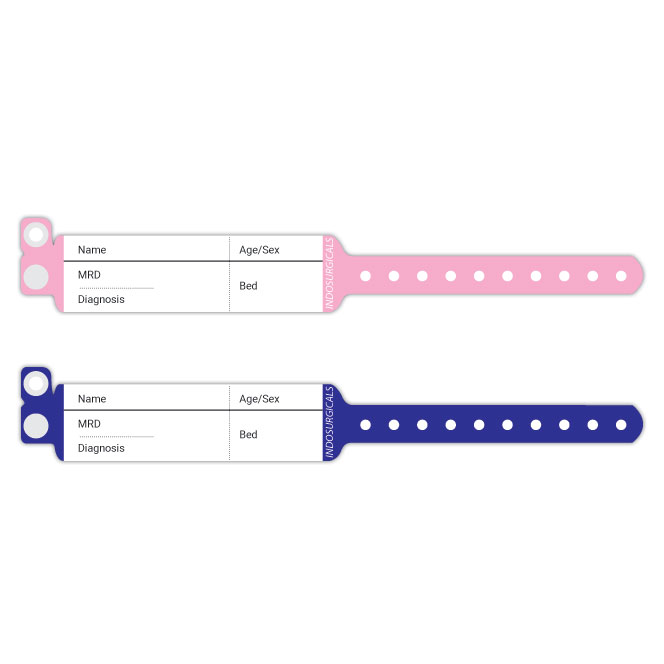Discovering the Various Sorts Of Patient Identification Band Used in Clinical Facilities
In the detailed globe of medical care, the essential function of Patient Identification bands usually goes undetected. These bands, varying from simple paper wristbands to advanced RFID bands, create the foundation of Patient safety and security procedures, ensuring accuracy in Patient Identification.
Comprehending the Relevance of Patient Identification Bands
While they might seem like mere devices, Patient Identification bands play an important function in clinical centers. These bands serve as an essential device for confirming Patient identity, avoiding medical errors associated to misidentification. Patient Identification bands additionally aid in enhancing administrative tasks, guaranteeing accurate record-keeping and payment.
Traditional Paper Wristbands: Their Usage and Limitations
Standard paper wristbands have actually been a staple in Patient Identification across various medical centers. While their usage prevails, they harbor particular constraints that might impact their effectiveness in Patient management. This area will focus on the range of their application and the inherent drawbacks connected with their use.
Paper Wristbands: Use Scope
In the realm of Patient Identification, paper wristbands have actually long held an important role. These bands are normally utilized in outpatient setups, where the Patient's stay is momentary. The wristbands contain essential details such as the Patient's name, date of birth, and a special Identification number. This easy, yet effective system, enables medical professionals to rapidly and accurately identify clients, making certain the appropriate therapy is provided. Paper wristbands are likewise made use of in emergency circumstances, where rapid Identification is paramount. Their use includes events like blood donation drives and mass vaccination programs, additionally highlighting their flexibility. Despite advancements in innovation, the humble paper wristband continues to be a trusted and cost-effective option for Patient Identification in different medical care situations.
Limitations of Paper Wristbands
Despite their prevalent use, paper wristbands are not without their downsides. In enhancement, paper wristbands typically do not have the technical capacities of more contemporary alternatives, such as barcoding or RFID chips, limiting their capability to just showing written details. Paper wristbands can cause discomfort or skin irritation to some patients, especially when put on for prolonged periods.
Barcoded Wristbands: Developments in Patient Identification
While Patient Identification has long been a critical aspect of medical care, the arrival of barcoded wristbands indicates a substantial leap forward. These bands utilize the simpleness of barcoding modern technology, enabling Patient details to be quickly scanned and accessed. They improve the rate and accuracy of Patient Identification, minimizing the threat of clinical errors connected to misidentification. Barcoded wristbands are cost-efficient, simple to generate, and get rid of handwriting errors usual with hand-operated systems. They are not without limitations. While they provide renovations over typical bands, the barcode can end up being smudged or used, rendering it unreadable. Despite this, barcoded wristbands remain a crucial tool in modern-day health care setups, representing the junction of modern technology and Patient treatment.
Radio Regularity Identification (RFID) Bands: a Step Towards Futuristic Health Care
The evolution of Patient Identification bands has caused the development of Radio Regularity Identification (RFID) Bands (patient identification band). These innovative tools existing essential advantages for health care facilities, providing a more reliable and technologically progressed methods of Patient Identification. The execution of RFID in healthcare is a substantial step in the direction of a much more advanced technique to Patient monitoring and security
Comprehending RFID Bands

RFID Bands: Trick Benefits
Mostly, these bands boost Patient security by offering accurate, immediate Identification, consequently decreasing medical errors. RFID bands can store a substantial quantity of Patient information, consisting of clinical history and allergic reactions, making it possible for personalized treatment. In general, RFID bands represent a substantial development in Patient Identification modern technology, profiting both clients and healthcare service providers.
Applying RFID in Medical Care
These bands supply a seamless means to track and determine individuals, ensuring their safety and boosting effectiveness in treatment procedures. RFID bands reduce clinical errors by giving exact Patient Identification, which is essential in protecting against misdiagnosis or wrong medicine administration. Hence, the implementation of RFID bands is a significant action towards improving Patient security and medical care delivery.

Color-Coded Wristbands: Helping in Quick and Accurate Medical Diagnosis
In the dynamic setting of a clinical center, color-coded wristbands have actually arised as essential tools for swift and exact Identification of a patient's clinical my explanation problem. These wristbands, put on by people, carry certain shades that represent different medical problems or conditions. Red can indicate allergy dangers, while yellow could symbolize a fall threat. This system is developed to offer instant visual signs to doctor, improving Patient safety and security and care top quality. In emergency situation circumstances, the use of these wristbands enables rapid decision-making. The efficiency of color-coded wristbands depends on the uniformity of color analysis throughout medical care establishments, needing typical criteria for consistent application.
Approaches for Effective Implementation and Administration of Patient ID Bands
Attaining optimal usage of Patient Identification bands demands a well-structured strategy for their execution and management. The initial action entails training all wellness workers on the relevance of appropriately using and reviewing these bands. Medical facilities ought to systematize the use of ID bands throughout all divisions, making sure harmony and decreasing disparities. Regular audits needs to be carried out to confirm adherence to plans and to correct any kind of incongruities. Patient education and learning is also crucial; people must understand the function of the bands and the demand for their consistent wear. patient identification band. Lastly, it's crucial to have a backup strategy in position, such as barcode scanning or biometrics, to guarantee that Patient Identification is never compromised.
Conclusion
Patient Identification bands are important in clinical centers to make sure security and accuracy. Conventional paper, barcoded, RFID, and color-coded wristbands each hold special advantages, varying from cost-effectiveness to sophisticated data storage space and immediate medical alerts. Effective implementation and management of these bands can significantly minimize clinical mistakes, increase effectiveness, and boost general Patient care. Hence, understanding and making use of these Identification tools is critical for maintaining high requirements in health care.
These bands, differing from simple paper wristbands to advanced RFID bands, form the foundation of Patient security procedures, ensuring precision in Patient Identification.The evolution of Patient Identification bands has brought concerning the introduction of Radio Frequency Identification (RFID) Bands. Generally, RFID bands stand for a substantial development in Patient Identification innovation, profiting both people and health care suppliers.
RFID bands reduce medical mistakes by look at this website offering accurate Patient Identification, which is important in stopping misdiagnosis or wrong medicine management. Patient education is likewise important; clients should recognize the function of the bands and the demand for their constant wear.